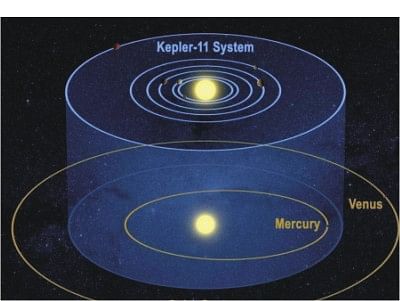Habitable exoplanets

This artist's conception shows the Kepler-11 planetary system and our solar system from a tilted perspective
Nasa's Kepler Spacecraft Telescope (KST) which was launched on 06 March 2009 with the objective of discovering Earth-like planets orbiting other suns in the constellations of Cygnus and Lyra. And on 02 February 2011, scientists from NASA announced that they have discovered with the aid of KST 54 new exoplanets (planets outside our solar system) where conditions are hospitable to extra-terrestrial life-forms! That means those 54 exoplanets are in the Goldilocks Zone, the region in a planetary system where the distance from a star and its orbiting planet is just right to maintain liquid water on its surface.
Using a "transiting" technique, Kepler spacecraft's ultra-precise photometer measures the tiny decreases in a star's brightness that occurs every time a planet that crosses in front of its host star. And with the aid of such mechanism, KST so far, have identified more than 1,200 planets (and counting) and of these 68 are approximately the size of the Earth, while 288 are super-Earth-sized; 662 are Neptune-sized, 165 are the size of Jupiter and 19 are larger than Jupiter. And of the 54 new planets that are thought to be in the habitable zone, five are about the size of Earth while the remaining 49 habitable zone candidates range from super-Earth sized (up to twice the size of Earth) to larger than Jupiter. And all these discoveries are the result of the observational studies conducted by NASA scientists between 12 May 12 and 17 Sept 2009, scanning more than 156,000 stars in KST's field of view, which basically covers 1/400 of the sky. According to Dr. William Borucki, head of Kepler's science program at NASA's Ames Research Center, "The fact that we've found so many planet candidates in such a tiny fraction of the sky suggests there are countless planets orbiting sun-like stars in our galaxy. We went from zero to 68 Earth-sized planet candidates and zero to 54 candidates in the habitable zone, some of which could have moons with liquid water". Along with this discovery, KST also identified a six-planet alien solar system, a significant astronomical finding, around the star system Kepler-11, which is 2,000 light-years from our very own Earth. Although the discovery of these 54 planets is exciting however, just because they are in the habitable zone that does not mean these planets are teeming with life-forms. Detailed study of the proper size, composition, temperature, atmospheric conditions of the exoplanets planets and much more are in order to ensure the fact that these planets house either microbial extra-terrestrial life forms or advanced civilization like ours and to even much more. Having said that, it is unanimously agreed that such discovery is truly a profound one and in the words of Charles Bolden, NASA administrator, "In one generation we have gone from extraterrestrial planets being a mainstay of science fiction, to the present, where Kepler has helped turn science fiction into today's reality. These discoveries underscore the importance of NASA's science missions, which consistently increase understanding of our place in the cosmos".

 For all latest news, follow The Daily Star's Google News channel.
For all latest news, follow The Daily Star's Google News channel. 



Comments